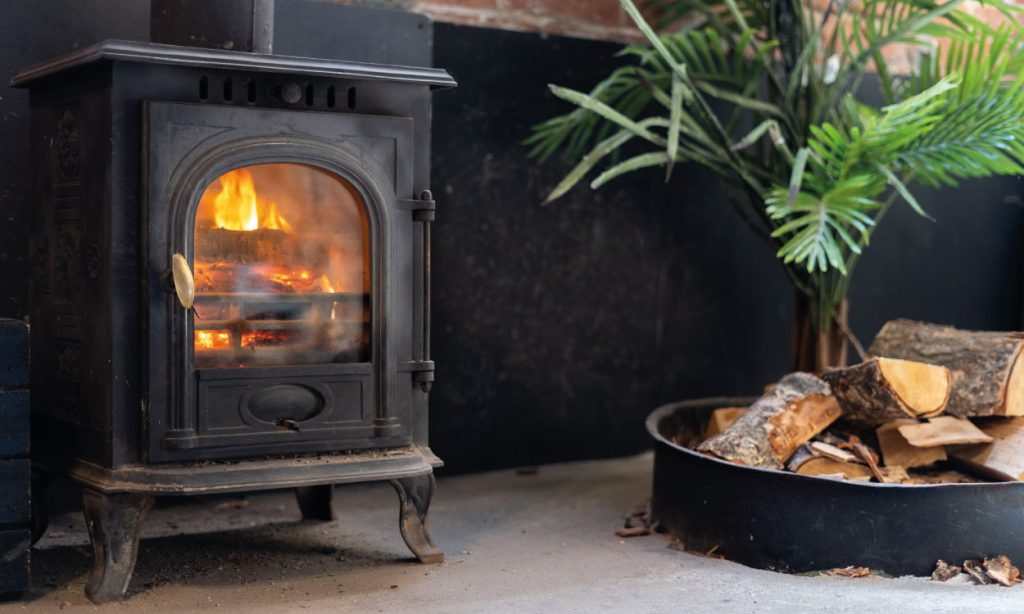How Much to Install a Log Burner

Installing a log burner in your home is a great way to add warmth, rustic charm and a relaxing ambience to a living space. With energy costs continuing to rise in the UK, more and more people are turning to wood-burning stoves as a reliable and cost-effective heating solution.
But, before you take the plunge and make the investment, it’s important that you understand all the costs involved. Prices can vary significantly, and this includes the cost of the log burner itself as well as the installation process.
In this article, we’ll take a look at everything you need to know about how much it costs to install a log burner, including the various factors that impact the cost.
Read on to find out more…

What Is A Log Burner?
A log burner, also known as a wood-burning stove, is a type of heating appliance designed to produce heat for residential spaces by burning wooden logs or wood-based fuels.
Typically, these stoves are constructed from cast iron or steel and feature a fire-resistant glass door to provide a captivating view of the flames while also safely containing them. Unlike traditional open fireplaces, log burners are much more efficient and also better for the environment as they provide greater heat output but with lower emissions.
Benefits Of Log Burners
In recent years, log burners have grown in popularity because they have a wide range of benefits. This includes:
- Energy efficiency: Unlike open fireplaces, log burners convert approximately 70-85% of the wood’s energy into heat, making them one of the most efficient heating options available.
- Cost savings: Energy price caps and overall costs continue to rise, and a log burner can provide an economical alternative – particularly for households that have access to affordable firewood and fuel.
- Aesthetic appeal: The cosy ambience of a real fire is a great way to add warmth and charm to any room. Furthermore, they also provide an aesthetic focal point that enhances interior design.
- Environmentally friendly: When the wood is sourced sustainably, using a log burner is considered to be a more environmentally friendly heating option. Kiln-dried logs are a renewable energy source, and even though the wood does emit carbon dioxide, this is still better than burning coal.
- Provides a backup heat source: During a power outage or emergency situation, log burners offer a reliable heating system that still be used. This means you never have to compromise your comfort. This is especially useful in rural settings.
- Clean to use: In contrast to open fireplaces, log burners are closed which means they do not spit coal or wood into the room, or emit fuel into your living space.
- Easy to control: Log burners allow the user to easily control the amount of air the stove takes in. This is not possible with open fires.
How Much Does A Log Burner Cost?
The price of a log burner itself can vary significantly depending on the size, brand and type you choose.
On average, you can expect to spend anywhere between £500 and £1,500 with the most typical price hovering around the £900 mark. However, some high-end models with advanced features can exceed the higher end of this range. Budget options are also available but their efficiency and longevity may be compromised.
Make sure you look at the stove’s efficiency rating, check the material it’s constructed from and any additional features it may have before making a purchase.
How Much Does It Cost To Install a log burner?
The installation of a log burner is usually the most expensive part of the process and will cost around £2,000 on average. However, the price may be more depending on the specifics of your individual project.
Costs can climb if:
- You don’t have a chimney
- The chimney needs lining
- Hearth installation is required
- A chimney flue needs to be installed or changed
- Safety compliance checks are required
Factors Impacting Log Burner Cost
There are a whole host of factors that will influence the overall cost of purchasing and installing a log burner.
This includes:
- Stove type and size: Larger stoves or models with advanced technology (such as dual combustion options) will generally be more expensive.
- Installation of complexity: Installing a log burner in a home without a chimney will require additional work. For example, a flue system will likely need to be constructed and this will increase the costs.
- Chimney lining: Ensuring a proper chimney lining is essential for safety and efficiency. The cost of this process will vary significantly depending on the size and condition of your chimney.
- Safety compliance: Meeting safety regulations and acquiring relevant certifications can add to the cost.
- Location: Installation prices can also differ depending on where you live as labour rates are often regionalised.
- Hearths: It is necessary to have a hearth installed to protect your floor. If you already have an existing hearth then you don’t need to worry but if you need a new one it can range from £50 to £400 for the materials alone. Hearths can be made from a range of materials including slate, glass, tiles and stone.
- Fireplace surrounds: If you want to add a fire surround to your log burner to enhance its aesthetics, then this will also add to the cost. Often, hearths are made from the likes of marble, timber, limestone and sandstone. Traditional and modern options are available and prices can start from £700 and rise as high as £3,000.
Can I Install A Log Burner Myself?
Yes, it is technically possible to install a log burner yourself. However, it is not advisable unless you are a professional or trained to do so.
Improper installation can lead to all kinds of health and safety risks, including fires, carbon monoxide poisoning and a log burner that does not function correctly.
In the UK, all installations also need to adhere to the Building Regulations, meaning it is always best to hire a certified professional who is registered with HETAS, or a similar regulatory body, to ensure the job is done correctly and legally.
While a DIY installation may save you money upfront, it could also result in costly repairs, insurance issues and even severe accidents in the future.
Where To Install A Log Burner
Proper placement of a log burner is essential for the safety, efficiency and overall enjoyment of your new stove.
Some factors you’ll need to consider include:
- Room size and layout: You must ensure the stove’s heat output aligns with the size and layout of the room it will be located in. This is to avoid problems such as overheating or underheating. The bigger the room, the more heat will be required to keep it warm and comfortable.
- Ventilation requirements: Adequate ventilation is crucial to provide the necessary oxygen for combustion and avoid air quality issues. You should choose a location that allows for airflow, and if you have a large log burner that has an output of more than 5.0kW an air vent will be required.
- Safety compliance: Ensure that the installation meets building regulations, including safe distances from combustible materials. For example, keep them clear of walls, furniture and curtains that may be a fire hazard.
- Flooring: All flooring under the log burner must be non-combustible. A hearth is almost always required to keep the floor safe. The hearth should extend a significant distance around the stove.
- Chimney or flue access: Having an existing chimney will reduce installation costs, but if you don’t have one then a twin-flue system may be required. If you do have one, this will help you determine the best location for the stone.
- Accessibility for maintenance: You must always make sure that the stove is positioned in a way that makes cleaning and maintenance as easy as possible.
The Cost Of Log Burner Alternatives
If you don’t want a log burner, there are several alternatives you can look at. Let’s take a look at some of these options and how much they cost.
- Pellet stoves: These stoves use pellets of wood or biomass to create energy. On average they cost around £2,000 to install.
- Gas stoves: Gas stoves usually produce less pollution than log burners. On average, they cost £1,500 to install and £750 for the stove itself.
- Electric stoves: These stoves run on electricity, but they can still provide the look and feel of open fireplaces or log burners. They are unlikely to be cheaper or more efficient to run but are a suitable alternative if a log burner is not appropriate. On average, it’ll cost around £1,050 for this stove and £700 for installation.
Installing a log burner can make for a fantastic addition to your home, providing warmth, aesthetic appeal and even potential savings on energy bills. While the initial costs can be substantial, the long-term benefits often outweigh the investment. To ensure a safe and effective installation, you should always seek the assistance of a professional.
The post How Much to Install a Log Burner appeared first on UK Home Improvement.







